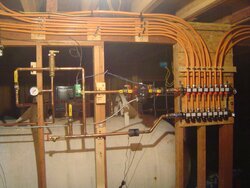I have a reset control with my oil-fired boiler that lowers output temp when outdoor temp is high (and vice versa). The idea being that boiler efficiency at lower temperatures. Is there an analogue for a gasifier with storage? For instance, the tank is fully charged, and conditions are right for 120F input water to the loop: would it pay to reduce the input to the emitters (somehow) to 120? How would one do this anyway, if it were indeed advisable and possible?
Or, would tapping into the hottest water from the tank and turning a circulating pump on and off periodically do it? Or, with some special pump that runs all the time that modulates, or something along that line. Until the tank extraction point temp got down to the lowest useable temp.
I'm sure this has been discussed already, somewhere. I'll keep reading.
Or, would tapping into the hottest water from the tank and turning a circulating pump on and off periodically do it? Or, with some special pump that runs all the time that modulates, or something along that line. Until the tank extraction point temp got down to the lowest useable temp.
I'm sure this has been discussed already, somewhere. I'll keep reading.



 . My supply temps for my in floor heat ranges from mid 90's to 120
. My supply temps for my in floor heat ranges from mid 90's to 120 T)across my radiant floor.
T)across my radiant floor.
